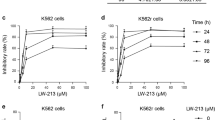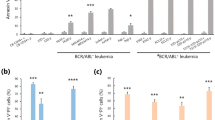Abstract
We previously demonstrated that quercetin, a naturally occurring flavonoid with strong antioxidant properties, was able to enhance programmed cell death in HPB-acute lymphoblastic leukemia (ALL) cell line, derived from a human tymoma, when associated with the agonistic anti-CD95 monoclonal antibody. Here, we report that HPB-ALL cells are normally resistant to CD95-mediated apoptosis, and quercetin is able to sensitize this cell line through a mechanism independent of its antioxidant properties. In fact, other compounds structurally and functionally similar to quercetin, when associated with anti-CD95 antibody did not induce any CD95-mediated apoptosis, still maintaining their antioxidant capacity. We found that quercetin effects are mediated by the activation of PKCα. Treatment of HPB-ALL cells with quercetin slightly decreased PKCα activity, but when the flavonoid was associated with anti-CD95, the kinase activity increased by 12-fold with respect to the treatment with quercetin. In addition, overexpression of PKCα induced programmed cell death in the absence of any additional stimulus, while a kinase-defective mutant of PKCα was ineffective. Our data confirm the involvement of specific PKC isoforms in CD95 signaling and suggest, for the first time, that quercetin targets this pathway increasing apoptogenic response in a cell line resistant to CD95-mediated apoptosis.
This is a preview of subscription content, access via your institution
Access options
Subscribe to this journal
Receive 50 print issues and online access
$259.00 per year
only $5.18 per issue
Buy this article
- Purchase on Springer Link
- Instant access to full article PDF
Prices may be subject to local taxes which are calculated during checkout









Similar content being viewed by others
Abbreviations
- DCFDA:
-
2′-7′-dichlorofluorescin diacetate
- DMSO:
-
dimethylsulfoxide
- IETD-AFC:
-
Ile-Glu-Thr-Asp-7-amino-4-trifluoromethyl coumarin
- LB:
-
lysis buffer
- LEHD-AFC:
-
Leu-Glu-Hys-Asp-7-amino-4-trifluoromethyl coumarin
- PBS:
-
phosphate-buffered saline
- PCD:
-
programmed cell death
- PKC:
-
protein kinase C
- PI3K:
-
inositol 1,4,5-triphosphate kinase
- PMA:
-
12-O-tetradecanoylphorbol-13-acetate
- T-TBS:
-
Tween-20/Tris-buffered saline
- ROS:
-
reactive oxygen species
- Z-DEVD-AFC:
-
carbobenzoxy-Asp-Glu-Val-Asp-7-amino-4-trifluoromethyl coumarin
References
Agullo G, Gamet-Payrastre L, Manenti S, Viala C, Remesey C, Chap H and Payrastre B . (1997). Biochem. Pharm., 53, 1649–1657.
Alderson MR, Tough TW, Braddy S, Davis-Smith T, Roux E, Schooley K, Miller RE and Lynch DH . (1994). Int. Immunol., 6, 1799–1806.
Avila M, Cansado J, Harter K, Velasco J and VN . (1996). Adv. Exp. Med. Biol., 401, 101–110.
Avila MA, Velasco JA, Cansado J and Notario V . (1994). Cancer Res., 54, 2424–2428.
Bors W, Heller W, Michel C and Saran M . (1990). Methods Enzymol., 186, 343–355.
Bradford MM . (1976). Anal. Biochem., 72, 248–254.
Caltagirone S, Rossi C, Poggi A, Ranelletti F, Natali P, Brunetti M, Aiello F and MP . (2000). Int. J. Cancer, 87, 595–600.
Casagrande F and Darbon J . (2001). Biochem. Pharmacol., 61, 1205–1215.
Chemoprevention Working Group. (1999). Cancer Res., 59, 4743–4758.
Chinnaiyan AM, O’Rourke K, Tewari M and Dixit VM . (1995). Cell, 81, 505–512.
Clement MV and Stamenkovic I . (1996). EMBO J., 15, 216–225.
Cuvillier O, Rosenthal DS, Smulson ME and Spiegel S . (1998). J. Biol. Chem., 273, 2910–2916.
Davies SP, Reddy H, Caivano M and Cohen P . (2000). Biochem. J., 351, 95–105.
Debatin KM and Krammer P . (1995). Leukemia, 9, 815–820.
Emoto Y, Manome Y, Meinhardt G, Kisaki H, Kharbanda S, Robertson M, Ghayur T, Wong WW, Kamen R, Weichselbaum R and Kufe D . (1995). EMBO J., 14, 6148–6156.
Fautz R, Husein B and Hechenberger C . (1991). Mutat. Res., 253, 173–179.
Ferrandina G, Almadori G, Maggiano N, Lanza P, Ferlini C, Cattani P, Piantelli M, Scambia G and Ranelletti FO . (1998). Int. J. Cancer, 77, 747–754.
Fiers W, Beyaert R, Declercq W and Vandenabeele P . (1999). Oncogene, 18, 7719–7730.
Frutos S, Moscat J and Diaz-Meco MT . (1999). J. Biol. Chem., 274, 10765–10770.
Galati G, Teng S, Moridani MY, Chan TS and O-Brien PJ . (2000). Drug Metabol. Drug Interact., 17, 311–349.
Gamet-Payrastre L, Manenti S, Gratacap MP, Tulliez J, Chap H and Payrastre B . (1999). Gen. Pharmacol., 32, 279–286.
Gillis S and Watson J . (1980). J. Exp. Med., 152, 1709–1719.
Goldberg D, Tsang E, Karumanchiri A, Diamandis E, Soleas G and Ngn E . (1996). Anal. Chem., 68, 1688–1694.
Gomez-Angelats M, Bortner CD and Cidlowski JA . (2000). J. Biol. Chem., 275, 19609–19619.
Gomez-Angelats M and Cidlowski JA . (2001). J. Biol. Chem., 276, 44944–44952.
Gschwendt M, Dieterich S, Rennecke J, Kittstein W, Mueller HJ and Johannes FJ . (1996). FEBS Lett., 392, 77–80.
Hagiwara M, Inoue S, Tanaka T, Nunoki K, Ito M and Hidaka H . (1988). Biochem. Pharmacol., 37, 2987–2992.
Hangartner M . (2000). Nature, 407, 770–776.
Hausler P, Papoff G, Eramo A, Reif K, Cantrell DA and Ruberti G . (1998). Eur. J. Immunol., 28, 57–69.
Ishikawa Y and Kitamura M . (2000). Biochem. Biophys. Res. Commun., 279, 629–634.
Iwao K and Tsukamoto I . (1999). Biochim. Biophys. Acta, 1427, 112–120.
Jacobson M, Weil M and Raff M . (1997). Cell, 88, 347–354.
Jamieson L, Carpenter L, Biden TJ and Fields AP . (1999). J. Biol. Chem., 274, 3927–3930.
Jarvis WD, Turner AJ, Povirk LF, Traylor RS and Grant S . (1994). Cancer Res., 54, 1707–1714.
Kang T and Liang N . (1997). Biochem. Pharmacol., 54, 1013–1018.
Kang ZC, Tsai SJ and Lee H . (1999). Nutr. Cancer, 35, 175–179.
Klas C, Debatin KM, Jonker RR and Krammer PH . (1993). Int. Immunol., 5, 625–630.
Krammer P . (2000). Nature, 407, 789–795.
Krammer PH, Galle PR, Moller P and Debatin KM . (1998). Advances in Cancer Research, Vol. 65. Vande Woude GF and Klein, G. (eds). Academic Press, Inc.: San Diego, pp. 251–272.
Laemmli UK . (1970). Nature, 227, 680–685.
Larocca LM, Ranelletti FO, Maggiano N, Rutella S, La Barbera EO, Rumi C, Serra F, Voso MT, Piantelli M, Teofili L and Leone G . (1997). Int. J. Cancer, 73, 75–83.
Le Good J, Ziegler W, Parekh D, Alessi D, Cohen P and Parker P . (1998). Science, 281, 2042–2045.
Le Marchand L, Murphy S, Hankin J, Wilkens L and LN K . (2000). J. Natl. Cancer Inst., 92, 154–160.
Li W, Zhang J, Flechner L, Hyun T, Yam A, Franke TF and Pierce JH . (1999). Oncogene, 18, 6564–6572.
Lowe S and Lin A . (2000). Carcinogenesis, 21, 485–495.
Mahmoud N, Carothers A, Grunberger D, Bilinski R, Churchill M, Martucci C, Newmark H and Bertagnolli M . (2000). Carcinogenesis, 21, 921–927.
Mandil R, Ashkenazi E, Blass M, Kronfeld I, Kazimirsky G, Rosenthal G, Umansky F, Lorenzo P, Blumberg P and Brodie C . (2001). Cancer Res., 61, 4612–4619.
Middleton EJ and Kandaswami C . (1993). The Flavonoid: Advance Research Since 1986. Hairbone JH and Liss AR (eds): New York, pp. 619–652.
Mizuno K, Noda K, Araki T, Imaoka T, Kobayashi Y, Akita Y, Shimonoka M, Kishi S and Ohno S . (1997). Eur. J. Biochem., 250, 7–18.
Morikawa S, Tatsumi E, Baba M, Harada T and Yasuhira K . (1978). Int. J. Cancer, 21, 166–170.
Mouria M, Gukovskaya AS, Jung Y, Buechler P, Hines OJ, Reber H and Pandol SJ . (2002). Int. J. Cancer, 98, 761–769.
Muzio M, Chinnaiyan AM, Kischkel FC, O’Rourke K, Shevchenko A, Ni J, Scaffidi C, Bretz JD, Zhang M, Gentz R, Mann M, Krammer PH, Peter ME and Dixit VM . (1996). Cell, 85, 817–827.
Nagata S . (1997). Cell, 88, 355–365.
Noroozi M, Burns J, Crozier A, Kelly IE and Lean ME . (2000). Eur. J. Clin. Nutr., 54, 143–149.
Parekh D, Ziegler W and Parker P . (2000). EMBO J., 19, 496–503.
Plaumann B, Fritsche M, Rimpler H, Brandner G and Hess RD . (1996). Oncogene, 13, 1605–1614.
Ranelletti F, Maggiano N, Serra F, Ricci R, Larocca L, Lanza P, Scambia G, Fattorossi A, Capelli A and Piantelli M . (2000). Int. J. Cancer, 85, 438–445.
Reddy BS . (2000). Cancer Epidemiol. Biomarkers Prev., 9, 239–247.
Rong Y, Yang EB, Zhang K and Mack P . (2000). Anticancer Res., 20, 4339–4345.
Ruiz-Ruiz MC, Robledo G, Font J, Izquierdo M and Lopez-Rivas A . (1999). J. Immunol., 163, 4737–4746.
Russo M, Palumbo R, Tedesco I, Mazzarella G, Russo P, Iacomino G and Russo G . (1999). FEBS Lett., 462, 322–328.
Scaffidi C, Fulda S, Srinivasan A, Friesen C, Li F, Tomaselli KJ, Debatin KM, Krammer PH and Peter ME . (1998). EMBO J., 17, 1675–1687.
Scaffidi C, Schmitz I, Korsmeyer S, Krammer PH and Peter ME . (1999). J. Biol. Chem., 274, 22532–22538.
Shao RG, Cao CX and Pommier Y . (1997). J. Biol. Chem., 272, 31321–31325.
Shimizu T, Cao CX, Shao RG and Pommier Y . (1998). J. Biol. Chem., 273, 8669–8674.
Stavric B . (1994). Clinical Biochem., 27, 319–332.
Toullec D, Pianetti P, Coste H, Bellevergue P, Grand-Perret T, Ajakane M, Baudet V, Boissin P, Boursier E and Loriolle F . (1991). J. Biol. Chem., 266, 15771–15781.
Wajant H, Haas E, Schwenzer R, Muhlenbeck F, Kreuz S, Schubert G, Grell M, Smith C and Scheurich P . (2000). J. Biol. Chem., 275, 24357–24366.
Walker E, Pacold M, Perisic O, Stephens L, Hawkins P, Wymann M and Williams R . (2000). Mol. Cell, 6, 909–919.
Wang I, Lin-Shiau S and Lin J . (1999). Eur. J. Cancer, 35, 1517–1525.
Weber G, Shen F, Yang H, Prajda N and Li W . (1999). Adv. Enzyme Regul., 39, 51–66.
Weisburger J . (2000). Am. J. Clin. Nutr., 71, 1710S–1714S.
Yang C, Landau J, Huang M and Newmark H . (2001). Annu. Rev. Nutr., 21, 381–406.
Acknowledgements
We thank the following colleagues for providing us several reagents used in the present study: Dr Weiqun Li for PKCα expressing vector; Drs Jae-Won Soh and I Bernard Weinstein for pHACE-PKC-KR plasmid; Dr Mauro Rossi for Jurkat cell line; Dr Luigia Santella for GF109203X. We also thank Drs Giavincenzo Barba and Paola Russo for their help in statistical analysis. This work has been supported by a grant from Istituto Superiore di Sanità (Roma, Italy), research project: ‘Natural antioxidants and effects on chronic-degenerative diseases.’
Author information
Authors and Affiliations
Corresponding author
Rights and permissions
About this article
Cite this article
Russo, M., Palumbo, R., Mupo, A. et al. Flavonoid quercetin sensitizes a CD95-resistant cell line to apoptosis by activating protein kinase Cα. Oncogene 22, 3330–3342 (2003). https://doi.org/10.1038/sj.onc.1206493
Received:
Revised:
Accepted:
Published:
Issue Date:
DOI: https://doi.org/10.1038/sj.onc.1206493
Keywords
This article is cited by
-
Taxifolin, a natural flavonoid interacts with cell cycle regulators causes cell cycle arrest and causes tumor regression by activating Wnt/ β -catenin signaling pathway
BMC Cancer (2018)
-
Phenolic compounds as biochemical markers of senescence in woody ornamental flowers of Malus crabapple
Horticulture, Environment, and Biotechnology (2018)
-
Quercetin downregulates Mcl-1 by acting on mRNA stability and protein degradation
British Journal of Cancer (2011)
-
Quercetin induced apoptosis in association with death receptors and fludarabine in cells isolated from chronic lymphocytic leukaemia patients
British Journal of Cancer (2010)
-
Quercetin enhances CD95- and TRAIL-induced apoptosis in leukemia cell lines
Leukemia (2007)



